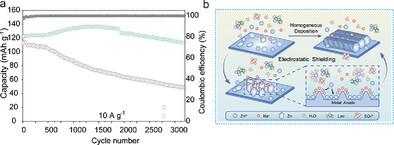无枝晶锌金属阳极的动态pH调节和界面离子重分配
IF 19
1区 材料科学
Q1 CHEMISTRY, MULTIDISCIPLINARY
引用次数: 0
摘要
由于析氢反应(HER)驱动的电解液碱化和不均匀的锌沉积,导致水溶液锌离子电池存在不可逆的阳极降解问题。本文提出了一种双功能缓冲添加剂,它能协同耦合pH调节和界面离子再分配。缓冲剂添加剂通过质子供体-受体平衡维持电解质的pH(≈3)自调节,有效清除羟基离子,防止Zn钝化,同时通过电荷筛选作用诱导Na⁺在突起处优先吸附,加强平面Zn沉积。这种双重机制使Cu-Zn半电池具有超低的成核过电位(24.5 mV)和超高的库仑效率(超过12000次循环99.9%)。使用NaV3O8阴极的完整电池在10 A g−1下循环3000次后容量保持率为93%,而袋状电池(20.89 mg cm−2阴极)在1 A g−1下循环300次后容量保持率为81.6%。这项工作建立了一个通用的范例,通过耦合热力学和动力学调节来稳定锌阳极,将锌离子电池定位为电网规模储能的可行候选人。本文章由计算机程序翻译,如有差异,请以英文原文为准。

Dynamic pH Regulation and Interfacial Ion Redistribution via Molecular Buffering for Dendrite-Free Zn Metal Anodes
Aqueous Zn ion batteries suffer from irreversible anode degradation caused by hydrogen evolution reaction (HER)-driven electrolyte alkalization and non-uniform Zn deposition. Here, a bi-functional buffer additive is proposed that synergistically couples pH regulation and interfacial ion-redistribution. The buffer additive maintains electrolyte with a self-regulated pH (≈3) through proton donor-acceptor equilibria, effectively scavenging hydroxyl ions to prevent Zn passivation, while inducing preferential Na⁺ adsorption at protrusions to enforce planar Zn deposition via charge screening effects. This dual mechanism enables an ultralow nucleation overpotential (24.5 mV) and an ultrahigh Coulombic efficiency (99.9% over 12 000 cycles) in Cu–Zn half cells. Full cells with NaV3O8 cathodes achieve 93% capacity retention after 3000 cycles at 10 A g−1, while pouch cells (20.89 mg cm−2 cathode) retain 81.6% capacity over 300 cycles at 1 A g−1. This work establishes a universal paradigm for stabilizing Zn anodes through coupled thermodynamic and kinetic regulation, positioning Zn-ion batteries as viable candidates for grid-scale energy storage.
求助全文
通过发布文献求助,成功后即可免费获取论文全文。
去求助
来源期刊

Advanced Functional Materials
工程技术-材料科学:综合
CiteScore
29.50
自引率
4.20%
发文量
2086
审稿时长
2.1 months
期刊介绍:
Firmly established as a top-tier materials science journal, Advanced Functional Materials reports breakthrough research in all aspects of materials science, including nanotechnology, chemistry, physics, and biology every week.
Advanced Functional Materials is known for its rapid and fair peer review, quality content, and high impact, making it the first choice of the international materials science community.
 求助内容:
求助内容: 应助结果提醒方式:
应助结果提醒方式:


